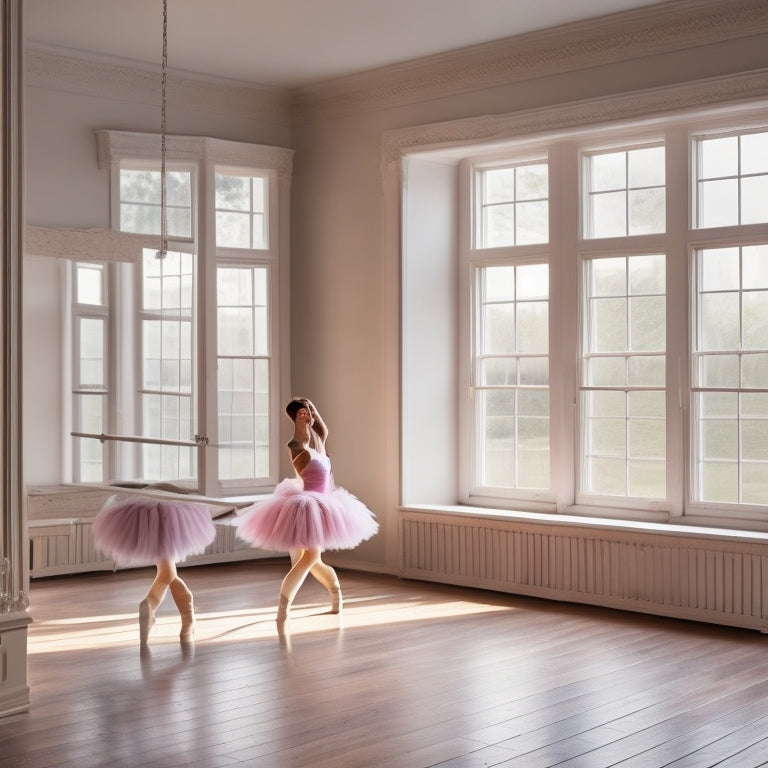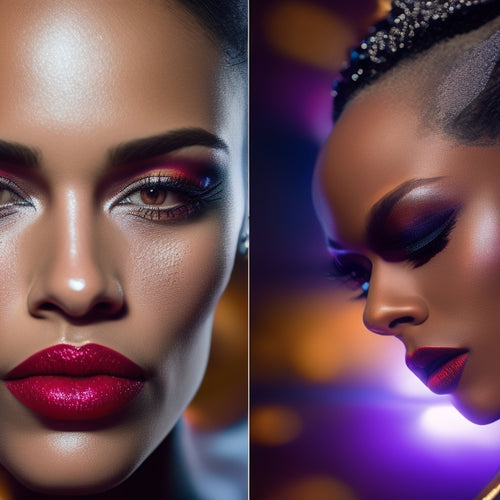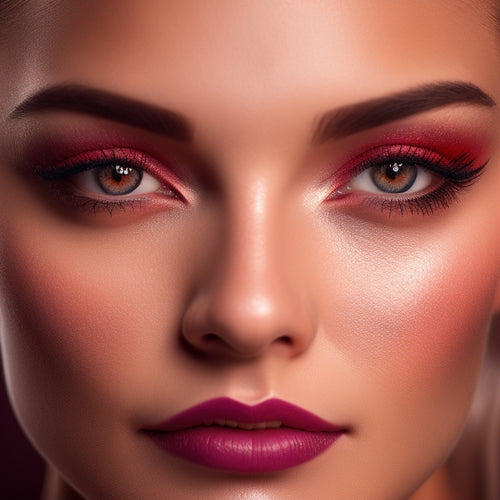
Most Comfortable Ballet Tutus for Dancers
Share
When searching for the most comfortable ballet tutus, prioritize breathable fabrics like chiffon and cotton blends. These materials boost airflow, keeping you cool during intense rehearsals. Look for designs that offer unmatched flexibility, allowing for a full range of motion without restrictions. Sizing is essential, so verify the tutu fits your waist perfectly to prevent discomfort. Durable fabrics not only withstand wear but also maintain their aesthetic appeal. For added comfort, choose tutus with moisture-wicking properties. When you know what to look for, you'll make an informed choice that enhances your performance. Investigate more options to improve your dance experience!
What You Need to Know
- Choose breathable fabrics like cotton blends and chiffon for improved airflow and moisture-wicking properties during performances.
- Opt for flexible materials with stretch to allow for a full range of motion and ergonomic support.
- Look for design features such as strategically placed cut-outs and adjustable waistbands to enhance airflow and comfort.
- Consider the durability of fabric types—tulle offers mobility, while cotton blends provide breathability for rigorous practices.
- Ensure accurate sizing for optimal fit, preventing injuries and enhancing overall appearance during performances.
Unmatched Flexibility for Movement
When you're dancing, the last thing you want is to feel restricted by your attire.
That's why choosing a tutu made from breathable fabrics and featuring an adaptive fit design is essential for ideal movement.
These elements not only enhance your comfort but also allow you to express your artistry with ease and grace.
Breathable Fabric Choices
Selecting the appropriate fabric for your ballet tutu can greatly improve your comfort and performance on stage. When you're dancing, you want to feel free and unrestricted, and breathable fabrics are essential to achieving that. Look for materials like cotton blends or moisture-wicking fabrics that allow for sweat management and temperature regulation. These choices help keep you cool when the spotlight's on and you're dancing your heart out.
Lightweight mesh and chiffon are excellent options as they provide that airy feel, letting your skin breathe while allowing the fabric to move with you. This means you won't feel weighed down, guaranteeing your focus remains on your performance rather than discomfort. You want to glide across the stage, not feel the fabric pulling against you.
Additionally, consider fabrics that offer a bit of stretch; they'll support your movements without constricting you. The right breathable fabric won't only improve your comfort but also boost your confidence as you dance, allowing you to express yourself fully.
Adaptive Fit Design
Adaptive fit design in ballet tutus brings unparalleled flexibility, allowing dancers to move with ease and confidence. These tutus incorporate adaptive features that adjust to your body, ensuring a snug yet comfortable fit.
You'll find that the ergonomic design not only enhances your silhouette but also supports your lively movements, whether you're leaping across the stage or executing delicate pirouettes.
Imagine slipping into a tutu that hugs your every curve without restriction. The innovative materials stretch and breathe, adapting to your unique shape as you dance. This means you won't have to worry about tugging or adjusting mid-performance; you can focus entirely on expressing yourself through movement.
Furthermore, the adaptive fit design promotes a full range of motion, allowing you to fully commit to each step without hesitation. Each spin, jump, and plié flows seamlessly, thanks to the thoughtful construction that considers both comfort and functionality.
When you choose a ballet tutu with these features, you're investing in a garment that truly understands the demands of dance, offering the freedom you crave while showcasing your artistry.
Cherish the elegance and support of adaptive fit design, and dance like never before.
Enhanced Breathability for Comfort
When choosing a ballet tutu, the fabric selection plays an important role in ensuring breathability and comfort during your performance.
Opting for lightweight, moisture-wicking materials can greatly enhance airflow, keeping you cool even in the heat of the moment.
Breathable and moisture-wicking materials are vital for minimizing sweat buildup and preventing discomfort.
Additionally, thoughtful design elements that promote airflow will help you focus on your movements without distraction.
Fabric Selection Importance
The fabric selection for ballet tutus can make a world of difference in a dancer's comfort and performance. Choosing the right fabric types helps guarantee you feel free and unrestricted as you move.
Look for materials like cotton, tulle, and chiffon, which are lightweight and breathable, allowing air to circulate around your body. This is especially important during long rehearsals or performances when heat can become a factor.
Your texture preferences play a significant role in how comfortable you'll feel. Some dancers prefer the soft touch of cotton against their skin, while others might opt for the smooth, flowing sensation of chiffon.
Each fabric type has its own unique qualities, and understanding these can help you find the perfect tutu that matches your needs.
Additionally, consider the stretchiness of the fabric. A little elasticity can provide extra comfort and freedom of movement, allowing you to focus on your performance without feeling constricted.
Ultimately, investing time in selecting the right fabric can enhance your experience, making each pirouette and leap feel effortless and enjoyable.
Accept the freedom of movement that comes with the right tutu, and let your artistry shine!
Design for Airflow
Creating a tutu with a focus on airflow is vital for maintaining comfort during intense dance sessions. When you're in the studio or on stage, you want to feel free and unencumbered, and proper design can make all the difference. Choosing lightweight, breathable fabrics like chiffon or mesh enhances the tutu aesthetics while allowing air to circulate. This not only keeps you cool but also helps wick away moisture, so you can stay focused on your performance.
Consider incorporating strategically placed cut-outs or layered designs that promote airflow, aligning with dancer preferences for both style and function. A well-designed tutu allows for movement without restriction, making it easier for you to execute those challenging pirouettes or grand jetés.
Additionally, adjustable waistbands and flexible structures can contribute to overall breathability, accommodating your body's movements. Prioritizing airflow in your tutu design is about more than just comfort; it's about embracing the freedom to express yourself fully as a dancer.
Ultimately, a balance between airflow and tutu aesthetics guarantees that you look stunning while feeling at ease, giving you the confidence to shine on stage.
Durable Fabric for Longevity
When choosing a ballet tutu, the type of fabric plays an essential role in its durability and lifespan.
Lightweight fabrics like tulle can provide both flexibility and ease of movement, making them ideal for dance performances.
You'll want to compare options like polyester, cotton, and tulle to find the best fit for your dancing needs.
Plus, knowing how to properly care for your tutu can greatly extend its life, ensuring you get the most out of your investment.
Fabric Types Comparison
Choosing the right fabric for your ballet tutu can make all the difference in your performance and comfort. When you investigate tutu fabric options, consider how each material affects your movement and longevity.
Common choices like tulle and chiffon offer different fabric textures that can influence how you feel on stage. Tulle is lightweight and airy, providing a classic look while allowing for excellent mobility. Its durability means it can withstand the demands of repeated performances.
Chiffon, on the other hand, has a softer, flowing feel, perfect for creating graceful lines. However, it might require a bit more care to maintain its appearance.
For those seeking a more sturdy option, cotton blends can offer durability and breathability. They provide a comfortable fit, resisting wear and tear from intense practice sessions.
Each fabric type has its pros and cons, so think about what feels best for you during your performances. Ultimately, the right tutu fabric not only enhances your aesthetic but also supports your freedom to express yourself through dance.
Care and Maintenance Tips
To keep your ballet tutu looking pristine and performing at its best, proper care and maintenance are key, especially for those made from durable fabrics.
Start by choosing the right cleaning methods. Hand washing in cold water with a gentle detergent is often best, as it preserves the tutu's shape and fabric integrity. Avoid wringing it out; instead, lay it flat on a clean towel to remove excess water. If you must machine wash, use a delicate cycle and a mesh garment bag for protection.
When it comes to storage tips, always hang your tutu on a padded hanger to maintain its poof and prevent creases. If you need to fold it for storage, place tissue paper between layers to avoid crushing the fabric. Keep your tutu in a breathable garment bag, away from direct sunlight, which can fade colors over time.
Lastly, check for any loose threads or embellishments regularly. Taking these simple steps will guarantee your tutu remains a cherished piece of your dance wardrobe, allowing you to move freely and confidently.
Enjoy every performance in your beautifully maintained tutu!
Sizing for Optimal Fit
To find the perfect fit for your ballet tutu, start by measuring your waist size accurately, as this guarantees comfort and ease of movement.
Proper fit is essential not only for appearance but also for enhancing performance and preventing injuries.
Next, consider the various tutu lengths available; each style can enhance your performance differently.
Understanding these key factors will help you select a tutu that not only looks great but also feels fantastic while you dance.
Measuring Your Waist Size
Accurate waist measurement is essential for finding the most comfortable ballet tutu that fits perfectly. To get started, you'll need some accurate sizing tools—a flexible measuring tape is your best friend here.
Stand in front of a mirror and locate the narrowest part of your waist, typically just above your belly button. Wrap the measuring tape around this area, making sure it's snug but not too tight. This is where waist measurement techniques come into play; take a deep breath and verify the tape remains level all around.
Once you've got the measurement, write it down. If you're in between sizes, don't hesitate to choose the larger option for comfort; after all, you want to move freely while dancing. Remember to double-check your measurement a couple of times for accuracy.
Lastly, keep in mind that different brands may have slightly varied sizing charts, so refer to those as you shop. With the right waist measurement, you'll be one step closer to finding a tutu that not only looks great but feels fantastic as you twirl and leap across the stage.
Understanding Tutu Lengths
Finding the right waist measurement is just the beginning; understanding tutu lengths is key to achieving the perfect fit for your dancing style. Tutu lengths vary considerably, and choosing the right one can enhance your movements, performance, and overall comfort.
There are primarily three tutu styles: classical, romantic, and contemporary. Classical tutus, often short and stiff, provide a sharp silhouette, ideal for traditional ballet. Romantic tutus, longer and softer, flow gracefully, allowing for more freedom in your movements. Contemporary styles can combine elements of both, offering flexibility and a unique aesthetic.
Historically, the evolution of tutu lengths has mirrored changes in ballet techniques and performance expectations. As you investigate your options, consider how each length affects your dancing. A shorter tutu may facilitate agility, while a longer one can enhance the visual impact of your spins and jumps.
When selecting your tutu, pay attention to how it aligns with your specific style and choreography. Ultimately, the right length won't only flatter your figure but also enable your dance, allowing you to express yourself freely and confidently on stage.
Superior Moisture-Wicking Properties
When you're dancing, staying comfortable is key, and that's where breathable fabric technology comes in.
These innovative materials are designed to wick away moisture, keeping you cool and dry during intense rehearsals or performances.
Incorporating elements of chronic tension management can also enhance your overall experience, ensuring that your body remains relaxed and ready for movement.
You'll appreciate how the right tutu not only enhances your movements but also helps manage sweat, allowing you to focus entirely on your artistry.
Breathable Fabric Technology
Utilizing advanced breathable fabric technology, today's ballet tutus guarantee dancers stay comfortable and focused during rehearsal and performance. This innovation isn't just about looking good; it's about feeling great while you dance. With superior moisture-wicking properties, these tutus keep you dry and allow your skin to breathe, promoting freedom of movement.
Here's how breathable fabric technology enhances your experience:
| Feature | Benefit |
|---|---|
| Moisture-wicking | Keeps you dry and fresh |
| Lightweight materials | Provides ease of movement |
| Quick-drying | Minimizes discomfort post-performance |
When you slip into a tutu crafted with these advanced materials, you're not just wearing a costume; you're donning a second skin that enhances your performance. Each twirl and leap feels liberated, allowing you to express your artistry without distraction. Fabric innovation in ballet tutus isn't merely a trend; it's a commitment to performance enhancement, ensuring that every dancer can reach for their dreams with confidence. Welcome the freedom of movement and uncover how the right tutu can alter your dance experience!
Frequently Asked Questions
Are There Specific Brands Known for Comfortable Ballet Tutus?
When searching for comfortable ballet tutus, consider brands like Grishko or Bloch. They offer various tutu styles customized to dancer preferences, ensuring freedom of movement while providing the support and comfort you need for practice or performance.
How Do I Care for My Ballet Tutu?
To care for your tutu, follow these tutu maintenance tips: hand wash in cold water using mild detergent, avoid wringing, and air dry away from sunlight. Proper washing techniques preserve its shape and enhance your dancing experience.
Can I Customize My Ballet Tutu for Performances?
Absolutely, you can customize your tutu! Investigate various tutu customization options to enhance performance outfit coordination. Adding unique colors, embellishments, or styles not only expresses your creativity but also boosts your overall stage presence.
What Materials Are Best for Sensitive Skin?
For sensitive skin, opt for natural fibers like cotton or bamboo, which offer breathability and softness. Moisture-wicking fabrics also help keep you dry, reducing irritation during performances and allowing you to move freely without discomfort.
Are There Ballet Tutus Designed for Plus Sizes?
You'll find stunning ballet tutus designed for plus sizes, celebrating inclusive sizing and body positivity. These tutus encompass your unique shape, allowing you to dance freely and confidently, feeling beautiful every step of the way.
Explore More
In the grand ballet of life, your tutu should be your trusted partner, allowing you to leap and twirl with grace. By choosing a tutu that offers unmatched flexibility, breathability, and durability, you're not just wearing a costume; you're donning a second skin that enables your every movement. When you find the perfect fit, you'll dance not just with your body, but with your spirit, embodying the freedom that only the most comfortable ballet tutus can provide.
Related Posts
-

Jazz Dance Makeup Tutorials for Dazzling On-Stage Looks
To achieve a dazzling on-stage look for your jazz dance performance, you'll want to focus on mastering stage makeup e...
-

Long-Lasting Dance Makeup: Tips for a Flawless Finish
To achieve a long-lasting dance makeup look, start by preparing your skin through cleansing, moisturizing, and exfoli...
-

Unleash Your Inner Showstopper: Tap-lesque Mini Course
This Tap-lesque Mini Course is an all-encompassing program designed to empower beginner to intermediate level tap dan...


